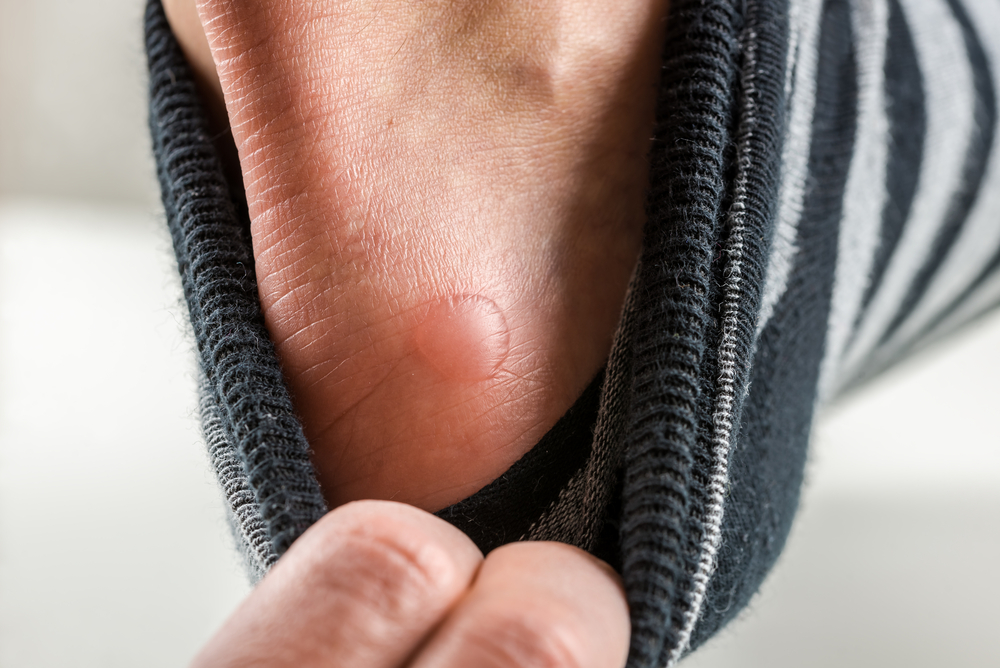Blisters are a common concern for many people, and there have been several studies over the years that have shown how some people are more susceptible to this type of injury than others. Although most people can heal on their own, you might want to see a foot doctor if you’re worried that the affected area isn’t healing or is getting infected. Here at Island Foot Clinics in Kelowna, BC, we have many ways of preventing and treating a blister.
Not only can we give you advice on how to prevent injury in the first place, but we can also tell you how to treat your feet, clean and dress your wound, prescribe orthotics and advise you on which pharmacy products are best, and drain your blister if it won’t go away on its own. Let’s now go over the different ways we can help you, and what you should do if your injury isn’t healing.
7 Ways a Foot Doctor Can Treat Painful Blisters
1. Giving You Great Prevention Advice
You may also struggle with injuries and infections more often if you have a bone spur on your foot, as most shoes won’t be able to accommodate this and will rub against it more frequently. No matter what the problem is, we can give you tips such as gradually breaking in new shoes, applying petroleum jelly to spots that have blistered before, and keeping good foot hygiene so that you won’t suffer from infections even if you do get a blister.
2. Telling You What Not to Do
If you have a painful blister, you can often resolve the issue at home or with over-the-counter remedies. However, there are certain things you should avoid, and it’s better to see a doctor just in case if you’re not sure. That way, we can tell you what you shouldn’t do and what actions could make your injury worse or cause an infection later on.
For example, you shouldn’t pop the blister on your own because there is a reason it’s there. The skin cover and the fluid inside your blister help to keep the underlying area clean, so that it can heal properly and without interference. When you call or email us about this condition, we can ask you questions about your blister and advise you on whether to leave it be or to visit us and have it drained professionally by a doctor.
3. Performing a Physical Examination
Your doctor will also ask you about why you think your blister is so painful and whether there’s a way you can prevent this in the future. If there’s a physical cause like a bunion, we will discuss further treatment options with you. You might be able to have the cause of your blister removed, or we might simply tell you about simple steps you can take to avoid blistering in the future.
4. Cleaning and Dressing Your Wound
To make sure you can take care of your feet after you go back home, we will go over the best ways to clean and dress your own injuries. In certain cases, you won’t be able to do this on your own, but often, you simply need the correct tools and knowledge. That way, you can prevent further visits to the clinic, even if you do get another blister in the future.
5. Prescribing a Custom Orthotic
If you frequently get painful blisters in the same spot, you might benefit from a prescription for orthotics. They can help to even out the weight distribution on your feet, so you won’t put excessive pressure on one area. The most important thing is that your orthotics are customized to your own situation, as they can do more damage than good if they aren’t correct for your feet. For this reason, you should always get them from a qualified foot doctor.
6. Recommending Pharmacy Products
Your doctor may also recommend certain products that will prevent blistering in the future. You might need to purchase petroleum jelly, which you can then apply to blister-prone spots whenever you wear new shoes or when you’ll be walking for a long time. There are also certain adhesive bandages available that can do the same job, or you can apply moleskin to the area.
7. Draining Your Blister
Get Your Painful Injury Treated Now
Although most blisters are minor, they can develop into a much more painful condition if they get infected. In some cases, your foot doctor can give you advice on how to treat them at home, but if they aren’t healing, you will need to see us in person. To learn more about blister treatments, give us a call at Island Foot Clinics in Kelowna, BC. We can help you to resolve the situation and prevent it from occurring again in the future.

